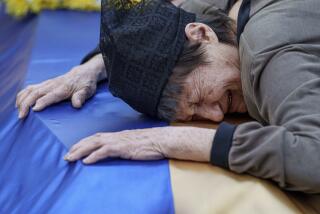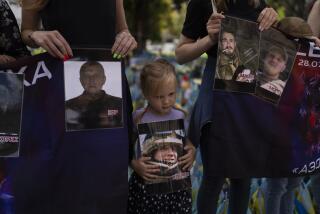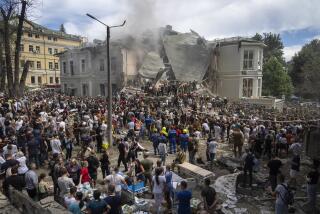NATO Concedes Civilians Killed in Bomb Attack
- Share via
WASHINGTON — Pentagon officials acknowledged Saturday that U.S. warplanes accidentally killed scores of ethnic Albanian refugees in an attack on a Yugoslav military outpost in Kosovo, but they sought to deflect blame by strongly suggesting that Serbian troops had used the refugees as “human shields” against a NATO assault.
While expressing regret for the civilian deaths near the village of Korisa, Pentagon spokesman Kenneth H. Bacon said NATO forces would step up, not scale back, the air campaign against the forces of Yugoslav President Slobodan Milosevic.
“NATO deeply regrets civilian casualties . . . but combat is inherently dangerous, and accidents cannot be avoided,” Bacon told reporters.
“The destruction will accelerate,” he added.
At NATO headquarters in Brussels, officials also defended Operation Allied Force, insisting that the three American F-16 fighter planes involved in the Thursday night attack had struck a “valid” target.
Neither U.S. officials nor NATO spokesmen could confirm the number of civilian casualties from the bombing near Korisa, but they said they had “no reason to doubt” reports from the official Yugoslav news agency, Tanjug, that fixed the toll at 87 dead and 78 wounded.
That count would make the NATO attack the deadliest yet on civilians. Indeed, official expressions of regret for civilian casualties and resolve to continue bombing have become a routine component of the U.S.-led alliance’s 54-day-old campaign against Milosevic.
Although NATO military planners say they have gone to extraordinary lengths to avoid killing noncombatants and striking civilian facilities, U.S.-built “smart bombs” and other high-technology systems have not averted a series of troubling mistakes.
On April 14, NATO mistakenly attacked columns of ethnic Albanian refugees near Djakovica; Yugoslav authorities said 75 people died in NATO attacks that day. Earlier this month, NATO aircraft struck the Chinese Embassy in Belgrade, the Yugoslav capital, killing three Chinese journalists. That blunder--blamed on outdated maps--set off days of violent anti-American protests in China and threatened to derail diplomatic efforts to end the Kosovo conflict.
The attacks on civilians have embarrassed NATO and cost the alliance public support. Officials acknowledged as much Saturday even as they blamed the Yugoslav leader for putting civilians in harm’s way.
“We think all of this is done to complicate targeting and to create exactly this type of public relations event that [Milosevic] thinks he can use to his advantage,” Bacon said.
“It has to make us more discriminating in the attacks, which can be difficult,” the Pentagon spokesman conceded.
Alliance pilots and other military officials acknowledged that NATO tactics, which are meant to safeguard fliers’ lives, don’t always allow pilots to see civilians before they attack.
The Yugoslav government, meanwhile, branded the Korisa attack proof of the “genocidal character” of NATO’s airstrikes and called on the United Nations and other international organizations to condemn “this crime against civilians” and stop the NATO attacks.
The target in the latest incident was a building that officials said NATO planners had been watching for two weeks before the attack and had concluded was a Yugoslav military outpost.
NATO military spokesman Maj. Gen. Walter Jertz said alliance reconnaissance had spotted an armored personnel carrier and 10 artillery pieces at the location. Immediately before launching his attack, the air controller in the first F-16 looked through his heat-sensitive targeting scope and identified what appeared to be dug-in, or revetted, military positions, Jertz said.
“You know it was by night, so he did see silhouettes of vehicles on the ground and, as it was by prior intelligence a valid target, he did do the attack,” the German general said.
The pilot who was working as air controller dropped two 500-pound laser-guided bombs, then signaled to his wingman to do the same, Jertz said.
Ten minutes later, the third F-16 arrived and showered the target with six unguided, or “gravity,” bombs, Jertz added.
Both Bacon and NATO spokesman Peter Daniel said there were no signs before the attack that civilians were also using the building and an adjacent parking area. Both men strongly suggested, but stopped short of claiming, that the Serb-led Yugoslav troops had encouraged refugees to camp in the area in order to provide a protective shield.
“We don’t have independent confirmation” that the troops were using the refugees as shields, Bacon said.
“What we do know is that [the refugees] ended up sleeping next to a building that the Serbs had to know was a target because we had hit many other installations like this,” Bacon said.
In Belgrade, Milisav Paic, a spokesman for the Yugoslav Foreign Ministry, dismissed such claims as “crazy.”
But Pentagon and NATO officials have claimed since the April 14 convoy bombings that Yugoslav forces regularly use refugees to shield targets from air attack, and Bacon elaborated on those claims Saturday.
“We’ve seen people on bridges, camping out on bridges, sleeping on bridges,” he said. “We’ve had reports of refugees being forced to stay under bridges so they could be killed if the bridge were struck. . . . And we’ve learned through the convoy accident . . . that [Milosevic] does integrate refugees into military convoys.”
On Friday and again Saturday, CNN aired grisly footage of an alleged massacre of 127 ethnic Albanians by Serbian soldiers in Kosovo on March 28. The network said it was unable to independently confirm any details provided by a Kosovo television journalist who said he filmed the aftermath of the event as he himself was escaping from the war-torn region.
*
Gosselin reported from Washington and Dahlburg from Brussels. Times staff writer Richard Boudreaux in Belgrade contributed to this report.
On the Web
Extended coverage of the crisis in Yugoslavia is available at The Times’ Web site at http://pixel.nohib.com./yugo. Coverage includes hourly updates, all Times stories since NATO launched its attack, video clips, information on how to help the refugees, a primer on the conflict and access to our discussion group.
More to Read
Sign up for Essential California
The most important California stories and recommendations in your inbox every morning.
You may occasionally receive promotional content from the Los Angeles Times.










